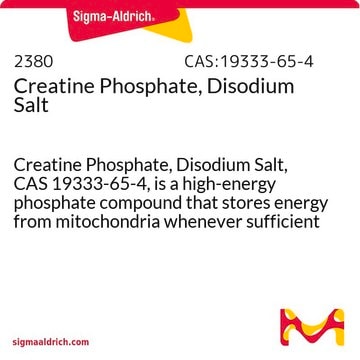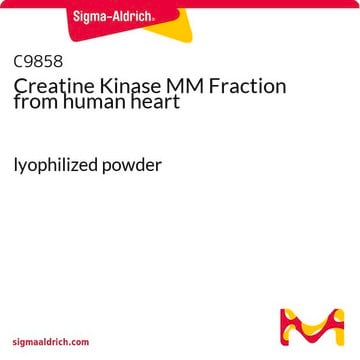Kluczowe dokumenty
C7886
Creatine Phosphokinase from bovine heart
Type III, salt-free, lyophilized powder, ≥30 units/mg protein
Synonim(y):
ATP: Creatine N-Phosphotransferase, CPK, Creatine Kinase, Phosphocreatine phosphokinase
Wybierz wielkość
276,00 zł
Wybierz wielkość
About This Item
276,00 zł
Polecane produkty
pochodzenie biologiczne
bovine heart
opis
Contains primarily isozyme MM
typ
Type III
Formularz
salt-free, lyophilized powder
aktywność właściwa
≥30 units/mg protein
masa cząsteczkowa
80 kDa
temp. przechowywania
−20°C
Opis ogólny
Fosfokinaza kreatynowa (CPK) jest enzymem wewnątrzkomórkowym występującym głównie w mięśniach szkieletowych, mózgu i mięśniu sercowym.[1] CPK składa się z dwóch podjednostek polipeptydowych, a mianowicie M (typ mięśniowy) i B (typ mózgowy). Lżejsza podjednostka jest obecna w większych ilościach.[2] Geny kodujące te podjednostki znajdują się na różnych chromosomach, z B na 14q32 i M na 19q13. Podjednostki te ułatwiają rozwój trzech specyficznych tkankowo izoenzymów: CPK-MB (mięsień sercowy), CPK-MM (mięśnie szkieletowe) i CPK-BB (mózg).[3]
Zastosowanie
- in the reaction mix for the import of in vitro synthesized wild-type FLAG/MYC-tagged LYR Motif Containing 7 (LYRM7-F/M) or the LFK tripeptide replaced with alanine (LFK-AAA) mutant into isolated mitochondria[4]
- in autoubiquitination assay[5]
- in the preparation of premix buffer for adenylyl cyclase activity[6]
- in the preparation of E-mix for in vitro nuclear assembly and isolation[7]
- in in vitro vesicular fusion assay.[8]
- in ATP regeneration system, to facilitate the reactivation of nonmotile axonemes.[9]
- in subcellular in vitro fusion assay of autophagosome with lysosome.[10]
- in in vitro protein translation assay.[11]
- for tATPase assay of myofibrillar protein isolated from rabbit. This assay evaluated the kinetic influence of bound creatine kinase (CK) on Ca2+-activated myosin ATPase.[12]
- for the enzymatic hydrolysis of protein samples during tryptophan estimation by pyrolysis gas chromatography.[13]
Działania biochem./fizjol.
Przestroga
Definicja jednostki
Komentarz do analizy
Kod klasy składowania
11 - Combustible Solids
Klasa zagrożenia wodnego (WGK)
WGK 3
Temperatura zapłonu (°F)
Not applicable
Temperatura zapłonu (°C)
Not applicable
Środki ochrony indywidualnej
Eyeshields, Gloves, type N95 (US)
Wybierz jedną z najnowszych wersji:
Certyfikaty analizy (CoA)
Nie widzisz odpowiedniej wersji?
Jeśli potrzebujesz konkretnej wersji, możesz wyszukać konkretny certyfikat według numeru partii lub serii.
Masz już ten produkt?
Dokumenty związane z niedawno zakupionymi produktami zostały zamieszczone w Bibliotece dokumentów.
Klienci oglądali również te produkty
Active Filters
Nasz zespół naukowców ma doświadczenie we wszystkich obszarach badań, w tym w naukach przyrodniczych, materiałoznawstwie, syntezie chemicznej, chromatografii, analityce i wielu innych dziedzinach.
Skontaktuj się z zespołem ds. pomocy technicznej













